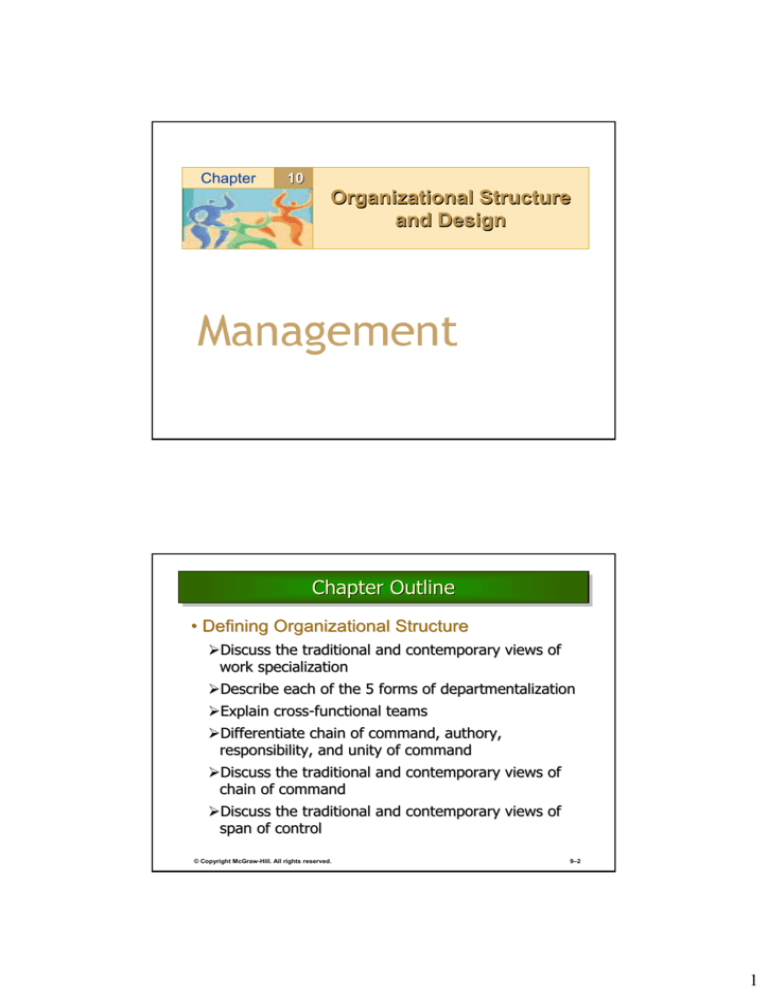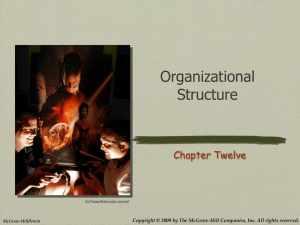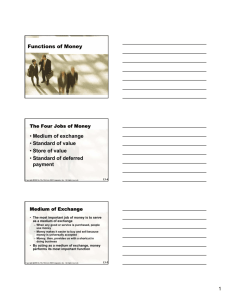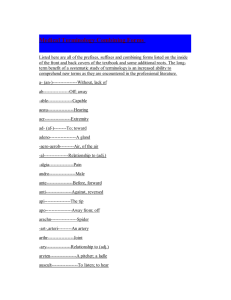
Chapter
10
Organizational Structure
and Design
Chapter
Chapter Outline
Outline
• Defining Organizational Structure
¾Discuss the traditional and contemporary views of
work specialization
¾Describe each of the 5 forms of departmentalization
¾Explain crosscross-functional teams
¾Differentiate chain of command, authory,
responsibility, and unity of command
¾Discuss the traditional and contemporary views of
chain of command
¾Discuss the traditional and contemporary views of
span of control
© Copyright McGraw-Hill. All rights reserved.
9–2
1
Chapter
’d)
Chapter Outline
Outline (cont
(cont’d)
¾Tell what factors influence the amount of centraliation
and decentralization
¾Explain how formalization is used in organizational
design
• Organizational Design Decisions
¾Contrast mechanistic and organic organizations
¾Explain the relationship between strategy and structure
¾Tell how organizational size affects organizational
design
¾Discuss Woodward’
Woodward’s findings on the relationship of
technology and structure
© Copyright McGraw-Hill. All rights reserved.
9–3
Chapter
’d)
Chapter Outline
Outline (cont
(cont’d)
¾Explain how environmental uncertainty affects
organizational design
• Common Organizational Designs
¾Contrast the three traditional organizational designs
¾Explain teamteam-based, matrix, and project structures
¾Discuss the design of virtual, network, and modular
organizations
¾Describe the characteristics of a learning organization
© Copyright McGraw-Hill. All rights reserved.
9–4
2
AA Manager
’s Dilemma
Manager’s
Dilemma
© Copyright McGraw-Hill. All rights reserved.
9–5
Organizing
Defining
Defining Organizational
Organizational Structure
Structure
• A vast factory complex make bombs for the US
Organizational
military
Structure
• A Canadian Customs and Revenue Agency
• Organizing
¾The process of creating an organization’
organization’s structure
• Organizational structure
¾It’
It’s the formal arrangement of jobs within an
organization
• Organizational design
¾A process that involves decisions about six key
elements: work specialization, departmentalization,
chain of command, span of control, etc
© Copyright McGraw-Hill. All rights reserved.
9–6
3
1.Work
1.Work Specialization
Specialization
• The degree to which tasks in an organization
are divided into separate jobs, also known as
division of labor
• Essence
¾An job is broken down into steps
¾Each step is compeleted by a different person
• During the first half of twentieth century, work
specialization did increase productivity, but it
is not as a source of ever-increasing
productivity
© Copyright McGraw-Hill. All rights reserved.
9–7
2.Departmentalization
2.Departmentalization
• The basis by which jobs are grouped together
¾Functional departmentalization
• Groups jobs by functions performed
Plant manager
Manager,
engineering
Manager,
Human resource
© Copyright McGraw-Hill. All rights reserved.
Manager,
accounting
Manager,
manufacturing
Manager,
purchasing
9–8
4
Departmentalization
Departmentalization
• The basis by which jobs are grouped together
¾Product departmentalization
• Groups jobs by product line
¾Geographical departmentalization
• Groups jobs on the basis of territory or grography
such as southern, midwestern, etc
© Copyright McGraw-Hill. All rights reserved.
9–9
Figure 9.6
© Copyright McGraw-Hill. All rights reserved.
9–10
5
Departmentalization
Departmentalization
• The basis by which jobs are grouped together
¾Process departmentalization
• Groups jobs on the basis of product or customer flow
Plant superinterdent
Planing
And Milling
Department
manager
Sawing
department
manager
Assembling
Department
manager
Lacquering
and sanding
Department
manager
© Copyright McGraw-Hill. All rights reserved.
9–11
Departmentalization
Departmentalization
• The basis by which jobs are grouped together
¾Customer departmentaliztion
• Groups jobs on the basis of customers who have
common needs or problems that can best be met by
having specialists for each
Director of slaes
Manager,
Retail accounts
Manager,
Wholesale accounts
© Copyright McGraw-Hill. All rights reserved.
Manager,
Government accounts
9–12
6
Departmentalization
Departmentalization
• Two popular trends in departmentalization
¾The increasing use of customer departmentalization
¾CrossCross-functional teams
• FORD
© Copyright McGraw-Hill. All rights reserved.
9–13
3.Chain
3.Chain of
of Command
Command
• The continuous line of authority that extends
from upper organizational levels to the lowest
levels and clarifies who reports to whom
¾Authority
• The rights inherent in a managerial position to tell
people what to do and to expect them to do it
¾Responsibility
• The obligation to perform any assigned duties
¾Unity of command
• The management principle that each person should
report to only one manager
© Copyright McGraw-Hill. All rights reserved.
9–14
7
4.Span
4.Span of
of Control
Control
• The number of employees a manager can
effciently and effectively manage
• The 2 organizations example
• Factors influencing the span of control
¾The skills and abilities of manager and the employees
¾Characeristics of the work being done
¾Similarity of employee tasks
¾The complexity of tasks
¾The physical proximity of subordinates
¾The degree to which standardized procedures,etc
© Copyright McGraw-Hill. All rights reserved.
9–15
Flat
Flat Organizations
Organizations
Figure 9.10a
© Copyright McGraw-Hill. All rights reserved.
9–16
8
Tall
Tall Organizations
Organizations
Figure 9.10b
© Copyright McGraw-Hill. All rights reserved.
9–17
5.Centralization
5.Centralization and
and Decentralization
Decentralization
• Centralization: the degree to which decision
making is concentrated at a single point in the
organization
• Decentralization: the degree to which lower-level
employees provide input or actually make
decisions
• A current distinct trend
¾Decentralizing decision making
• Factors influencing the amount of centralization
and decentralization
© Copyright McGraw-Hill. All rights reserved.
9–18
9
6.Formalization
6.Formalization
• To the degree to which jobs within the
organization are standardized and the extent to
which employee behavior is guided by rules and
procedures
• The strengths and weaknesses of formalization
© Copyright McGraw-Hill. All rights reserved.
9–19
Organizational
Organizational Design
Design Decisions
Decisions
• Mechanistic and Organic Organizations
How to chooseafrom
¾Mechanistic organizations:
rigid and tighty controlled
these 2?
structure
Which
one isdepartmentalization/Narrow
more
• High specialization/Rigid
appropriate?
spans of control/High
formalization/A limited information
network/Little participation in decision making by lowerlowerlevel employees
¾Organic organizations: an organization design that’
that’s
highly adaptive and flexible
• Flexible/Division of labor/
© Copyright McGraw-Hill. All rights reserved.
9–20
10
Organizational
Organizational Design
Design Decisions
Decisions
• Contigency factors
¾Stragety and structure
• A differentiation strategy needs a flexible structure, low cost
may need a more formal structure.
• Increased vertical integration or diversification also requires
a more flexible structure.
¾Size and structure
¾Technology and sructure
¾Environmental uncertainty and structure
© Copyright McGraw-Hill. All rights reserved.
9–21
Determinants
Determinants of
of Structure
Structure
• Technology
¾The combination of skills, knowledge, tools,
equipment, computers and machines used in the
organization.
¾More complex technology makes it harder for
managers to regulate the organization.
© Copyright McGraw-Hill. All rights reserved.
9–22
11
Determinants
Determinants of
of Structure
Structure
• Technology (cont’d)
¾Technology can be measured by:
• Task variety: the number of new problems a manager
encounters.
• Task analyzability: the availability of programmed
solutions to a manager to solve problems.
¾High task variety and low analyzability present
many unique problems to managers.
• Flexible structure works best in these conditions.
¾Low task variety and high analyzability allow
managers to rely on established procedures.
© Copyright McGraw-Hill. All rights reserved.
9–23
Types
Types of
of Technology
Technology
• Small Batch Technology
¾Small quantities of oneone-ofof-a-kind products are
produced by the skills of the workers who work
together in small groups.
• Appropriate structure is decentralized and flexible.
• Mass Production Technology
¾Automated machines that are programmed to make
high volumes of standard products.
• Formal structure is the best choice for workers who
must perform repetitive tasks.
© Copyright McGraw-Hill. All rights reserved.
9–24
12
Types
Types of
of Technology
Technology
• Continuous Process Technology
¾Totally mechanized systems of automatic machines.
• A flexible structure is necessary to allow workers to
react quickly to unexpected problems.
• Information Technology (IT)
¾Knowledge management
• The sharing and integrating of expertise within and
between functions and divisions through realtime,
realtime,
interconnected IT that allows for new kinds of tasks
and job reporting relationships.
© Copyright McGraw-Hill. All rights reserved.
9–25
Job
Job Design
Design
• Job Design
¾The process by which managers decide how to
divide tasks into specific jobs.
¾The appropriate division of labor results in an
effective and efficient workforce.
• Job Simplification
¾The process of reducing the tasks each worker
performs.
• Too much simplification and boredom results.
© Copyright McGraw-Hill. All rights reserved.
9–26
13
Job
Job Design
Design
• Job Enlargement
¾Increasing the number of tasks for a given job to
reduce boredom.
• Job Enrichment
¾Increasing the degree of responsibility a worker has
over a job.
¾can lead to increased worker involvement.
© Copyright McGraw-Hill. All rights reserved.
9–27
The
The Job
Job Characteristics
Characteristics Model
Model
Source: Adapted from J. R. Hackman and G. R. Oldham,
Work Redesign (Reading, MA: Addison-Wesley, 1980).
© Copyright McGraw-Hill. All rights reserved.
Figure 9.2
9–28
14
Job
Job Characteristics
Characteristics Model
Model
Job Characteristic
Skill variety
Employee uses a wide range of skills.
Task identity
Worker is involved in all tasks of the job
from beginning to end of the production
process
Task significance
Worker feels the task is meaningful to
organization.
Autonomy
Employee has freedom to schedule tasks
and carry them out.
Feedback
Worker gets direct information about how
well the job is done.
© Copyright McGraw-Hill. All rights reserved.
9–29
Common
Common Organizational
Organizational Designs
Designs
• Traditional organizational design
¾Simple structure
• An organizational design with low departmentalization,
wide spans of control, anthority centralization in a
single person, and little formalization
¾Functional structure
• An organization design that groups similar or related
occupational specialties together
¾Divisional structure
• An organization structure made up of separate
business units or divisions
© Copyright McGraw-Hill. All rights reserved.
9–30
15
Divisional
Divisional Structures
Structures
• Divisional Structure
¾An organizational structure composed of separate
business units within which are the functions that
work together to produce a specific product for a
specific customer
• Divisions create smaller, manageable parts of a firm.
• Divisions develop a businessbusiness-level strategy to
compete.
• Divisions have marketing, finance, and other
functions.
• Functional managers report to divisional managers
who then report to corporate management.
© Copyright McGraw-Hill. All rights reserved.
9–31
FFunctional
unctional
structure
structure
© Copyright McGraw-Hill. All rights reserved.
9–32
16
Divisional
Divisional
structure
structure
© Copyright McGraw-Hill. All rights reserved.
9–33
Common
Common Organizational
Organizational Designs
Designs
• Contemporary organizational designs
¾ Team structures
• The organization is made up of work groups or teams
¾ Matrix and project structures
• Matrix structure
• Project structure
¾ The boundaryless organization
• An organization whose design is not defined, or limited to, the
horizontal, vertical, or external boundaries imposed by a
predefined structure
¾ The learning organization
• An organization that has developed the capacity to continuously
learn, adapt, and change
© Copyright McGraw-Hill. All rights reserved.
9–34
17
Matrix
Matrix
structures
structures
© Copyright McGraw-Hill. All rights reserved.
9–35
M
atrix and
Matrix
and
project
project structrues
structrues
• Matrix structue: an organizational structure that assigns
specialists from different functional departments to work
on one or more projects being led by project managers
• Features
¾ A dual chain of command, employees have 2 managers: their
functional department manager
¾ Results in a complex network of superiorsuperior-subordinate reporting
relationships.
¾ The structure is very flexible and can respond rapidly to the need
need
for change.
¾ Each employee has two bosses (functional manager and product
manager) and possibly cannot satisfy both.
© Copyright McGraw-Hill. All rights reserved.
9–36
18
Product
Product Team
Team Structure
Structure
Figure 9.7
© Copyright McGraw-Hill. All rights reserved.
9–37
M
atrix and
Matrix
and
project
project structrues
structrues
• Project structures: a project structure has no
formal departments that employees return to
at the completion of a project. Instead,
employees take their specific skills, abilities,
and experience to other projects.
• Project structures tend to be fluid and flexible
organizational designs
© Copyright McGraw-Hill. All rights reserved.
9–38
19
The
The boundaryless
boundaryless
organization
organization
• Boundaries
¾Internal boundaries
• Horizontal boundaries: imposed by work specialization and
departmentalization
• Vertical boundaries: separate employees into
organizational levels and hierarchies
¾External boundaries
• Separate the organization from its customers, suppliers,
and other stakeholders
© Copyright McGraw-Hill. All rights reserved.
9–39
The
The boundaryless
boundaryless
organization
organization
• Virtual organization:
¾an organization consists of a small core of fullfull-time
employees and that temporarily hires outside specialists
to work on opportunities that arise
• Network organization:
¾a small core organization that oursources major business
functions
• Modular organizaiton:
¾A manufacturing organization that uses suppliers to
provide product components or modules which are then
assembled into final products
© Copyright McGraw-Hill. All rights reserved.
9–40
20
The
The learning
learning
organization
organization
Organizational
culture
• strong mutual
relationships
• sense of
community
• caring
• trust
Organizational design
• boundaryless
• teams
• empowerment
Thelearning
learning
The
organization
organization
Information
sharing
• open
• timely
• accurate
Leadership
• shared vision
• collaboration
© Copyright McGraw-Hill. All rights reserved.
9–41
Factors
Factors Affecting
Affecting Organizational
Organizational Structure
Structure
Figure 9.1
© Copyright McGraw-Hill. All rights reserved.
9–42
21
Integrating
Integrating Mechanisms
Mechanisms
Figure 9.11
© Copyright McGraw-Hill. All rights reserved.
9–43
Forms
Forms of
of Integrating
Integrating Mechanisms
Mechanisms
Source:
© Copyright McGraw-Hill. All rights reserved.
Figure 9.12
9–44
22








